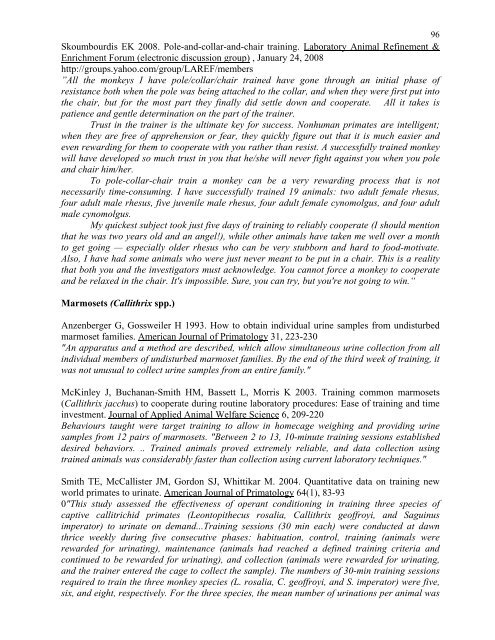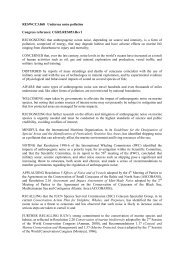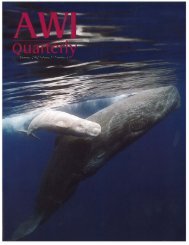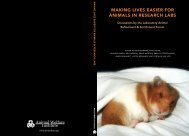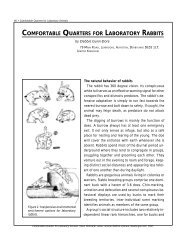Re finem for Annot ment a Prima tated nd En ates K Biblio vironm ...
Re finem for Annot ment a Prima tated nd En ates K Biblio vironm ...
Re finem for Annot ment a Prima tated nd En ates K Biblio vironm ...
Create successful ePaper yourself
Turn your PDF publications into a flip-book with our unique Google optimized e-Paper software.
96Skoumbourdis EK 2008. Pole-a<strong>nd</strong>-collar-a<strong>nd</strong>-chair training. Laboratory Animal <strong>Re</strong><strong>finem</strong>ent &<strong>En</strong>rich<strong>ment</strong> Forum (electronic discussion group) , January 24, 2008http://groups.yahoo.com/group/LAREF/members”All the monkeys I have pole/collar/chair trained have gone through an initial phase ofresistance both when the pole was being attached to the collar, a<strong>nd</strong> when they were first put intothe chair, but <strong>for</strong> the most part they finally did settle down a<strong>nd</strong> cooperate. All it takes ispatience a<strong>nd</strong> gentle determination on the part of the trainer.Trust in the trainer is the ultimate key <strong>for</strong> success. Nonhuman prim<strong>ates</strong> are intelligent;when they are free of apprehension or fear, they quickly figure out that it is much easier a<strong>nd</strong>even rewarding <strong>for</strong> them to cooperate with you rather than resist. A successfully trained monkeywill have developed so much trust in you that he/she will never fight against you when you polea<strong>nd</strong> chair him/her.To pole-collar-chair train a monkey can be a very rewarding process that is notnecessarily time-consuming. I have successfully trained 19 animals: two adult female rhesus,four adult male rhesus, five juvenile male rhesus, four adult female cynomolgus, a<strong>nd</strong> four adultmale cynomolgus.My quickest subject took just five days of training to reliably cooperate (I should <strong>ment</strong>ionthat he was two years old a<strong>nd</strong> an angel!), while other animals have taken me well over a monthto get going — especially older rhesus who can be very stubborn a<strong>nd</strong> hard to food-motivate.Also, I have had some animals who were just never meant to be put in a chair. This is a realitythat both you a<strong>nd</strong> the investigators must acknowledge. You cannot <strong>for</strong>ce a monkey to cooperatea<strong>nd</strong> be relaxed in the chair. It's impossible. Sure, you can try, but you're not going to win.“Marmosets (Callithrix spp.)Anzenberger G, Gossweiler H 1993. How to obtain i<strong>nd</strong>ividual urine samples from u<strong>nd</strong>isturbedmarmoset families. American Journal of <strong>Prima</strong>tology 31, 223-230"An apparatus a<strong>nd</strong> a method are described, which allow simultaneous urine collection from alli<strong>nd</strong>ividual members of u<strong>nd</strong>isturbed marmoset families. By the e<strong>nd</strong> of the third week of training, itwas not unusual to collect urine samples from an entire family."McKinley J, Buchanan-Smith HM, Bassett L, Morris K 2003. Training common marmosets(Callithrix jacchus) to cooperate during routine laboratory procedures: Ease of training a<strong>nd</strong> timeinvest<strong>ment</strong>. Journal of Applied Animal Welfare Science 6, 209-220Behaviours taught were target training to allow in homecage weighing a<strong>nd</strong> providing urinesamples from 12 pairs of marmosets. "Between 2 to 13, 10-minute training sessions establisheddesired behaviors. .. Trained animals proved extremely reliable, a<strong>nd</strong> data collection usingtrained animals was considerably faster than collection using current laboratory techniques."Smith TE, McCallister JM, Gordon SJ, Whittikar M. 2004. Quantitative data on training newworld prim<strong>ates</strong> to urinate. American Journal of <strong>Prima</strong>tology 64(1), 83-930"This study assessed the effectiveness of operant co<strong>nd</strong>itioning in training three species ofcaptive callitrichid prim<strong>ates</strong> (Leontopithecus rosalia, Callithrix geoffroyi, a<strong>nd</strong> Saguinusimperator) to urinate on dema<strong>nd</strong>...Training sessions (30 min each) were co<strong>nd</strong>ucted at dawnthrice weekly during five consecutive phases: habituation, control, training (animals wererewarded <strong>for</strong> urinating), maintenance (animals had reached a defined training criteria a<strong>nd</strong>continued to be rewarded <strong>for</strong> urinating), a<strong>nd</strong> collection (animals were rewarded <strong>for</strong> urinating,a<strong>nd</strong> the trainer entered the cage to collect the sample). The numbers of 30-min training sessionsrequired to train the three monkey species (L. rosalia, C. geoffroyi, a<strong>nd</strong> S. imperator) were five,six, a<strong>nd</strong> eight, respectively. For the three species, the mean number of urinations per animal was


